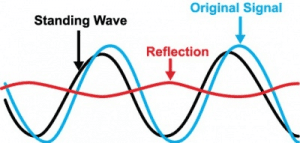From the moment that a modulated Radio Frequency (RF) signal leaves a Power Amplifier and begins its journey to a receiver, the amplitude with respect to the ambient noise starts to decrease. When the signal arrives at the receiver, it needs to be sufficiently higher than the noise for the receiver to properly demodulate the RF signal and recover the data.
What constitutes “sufficiently higher”, or the minimum Signal to Noise Ratio (SNR), depends on the type of modulation and processing used to encode and recover the data. However, no matter what type of modulation is used, the first thing the receiver needs to accomplish is stopping the reduction of the SNR. This task is accomplished with a Low Noise Amplifier (LNA).
All active circuits contribute noise. However, LNAs are a special type of active Radio Frequency (RF) circuit that have been specifically designed to increase the amplitude of an RF signal without adding much additional noise. LNAs can be used in different scenarios to improve the operating range or reliability of a system
One such scenario deals with simply improving the Noise Figure of a system. The amount of noise that a circuit or a system contributes is indicated by parameters called Noise Factor (linear scale measurement) and Noise Figure (logarithmic scale measurement). RF engineers typically work in logarithmic scales so the Noise Figure is the most common parameter provided in data sheets.
If the Noise Figure of a receiver is 7 or 8 dB, then using an LNA with a Noise Figure of 1 dB in front of the receiver will improve the total system’s Noise Figure and potentially double the operational range. This is because the receiver’s higher Noise Figure will reduce the SNR by 6 or 7 dB more than if the LNA is used.

Figure 1: NuWaves RF Solutions offers a wide selection of LNAs to meet the needs of your communications systems.
Another scenario where an LNA can improve a system’s performance is the remote installation of a receiver’s antenna. After the antenna captures the RF signal, the signal must pass along a coaxial cable to the receiver. The coaxial cable will create additional amplitude loss before the signal finally reaches the receiver. An LNA that has more gain than the coaxial cable’s loss can be installed right after the antenna to prevent this loss from affecting the performance of the system and in effect, allow the system to perform as if the receiver was installed at the top of the tower next to the antenna.
These are just two simple examples of how an LNA can improve the performance of your system. By improving the system’s noise figure and reducing the RF signal’s amplitude losses an LNA is an invaluable component in communications systems. NuWaves offers a full spectrum of solutions including Low Noise Amplifier Design Services and a full line of COTS Low Noise Amplifiers.


